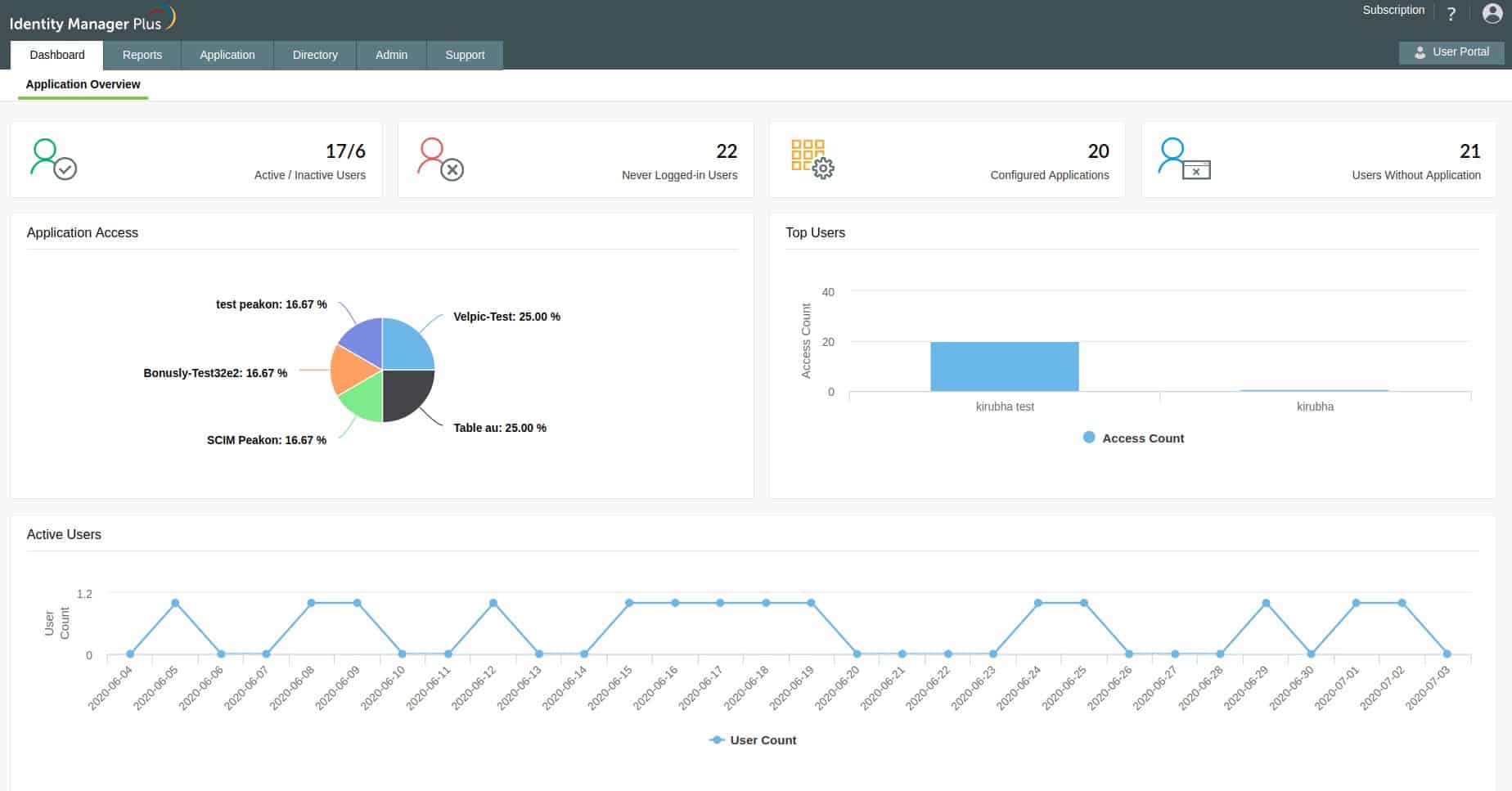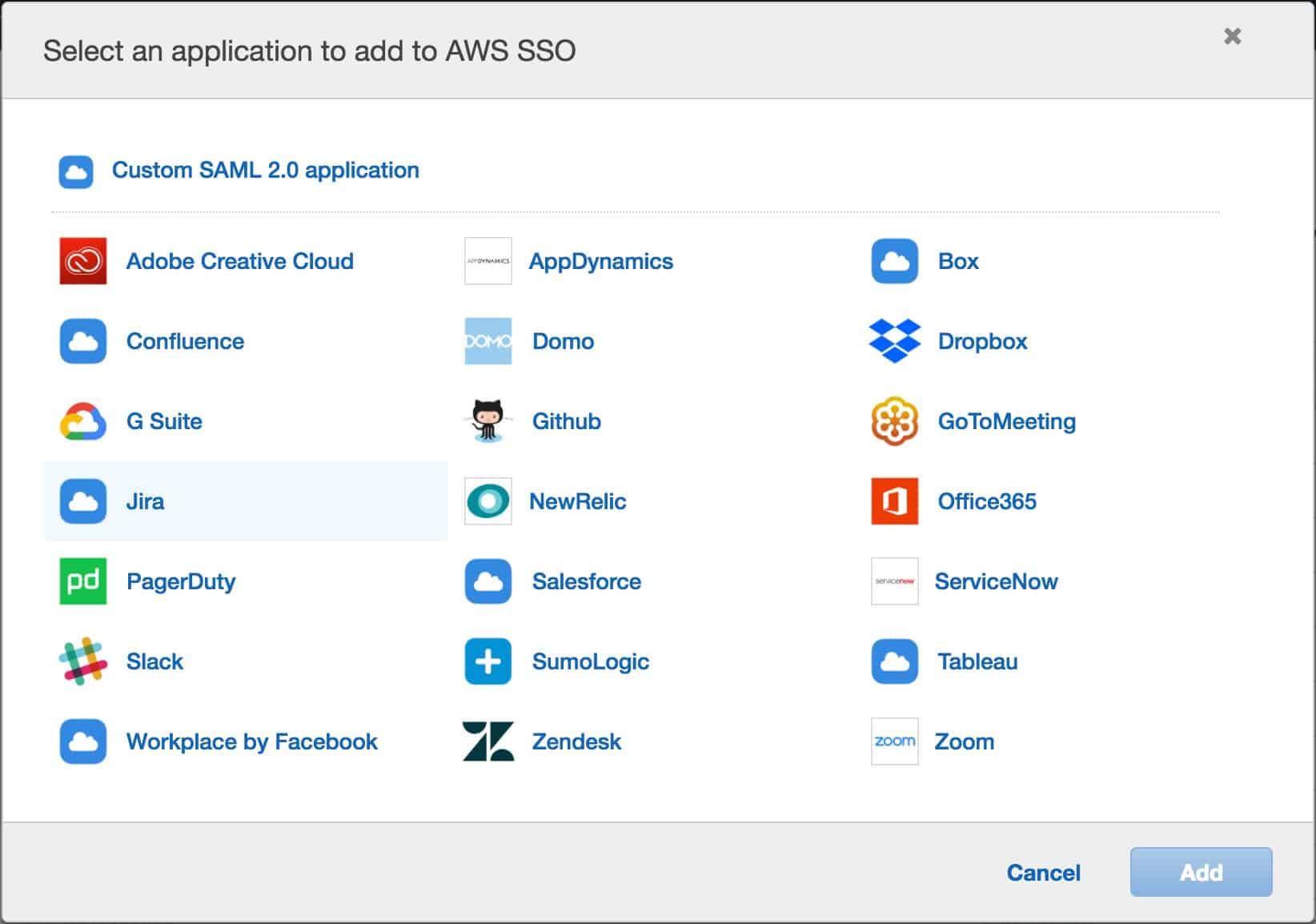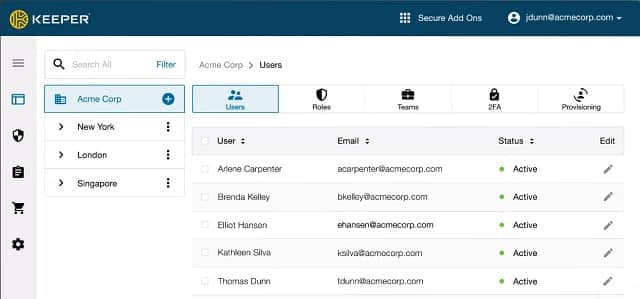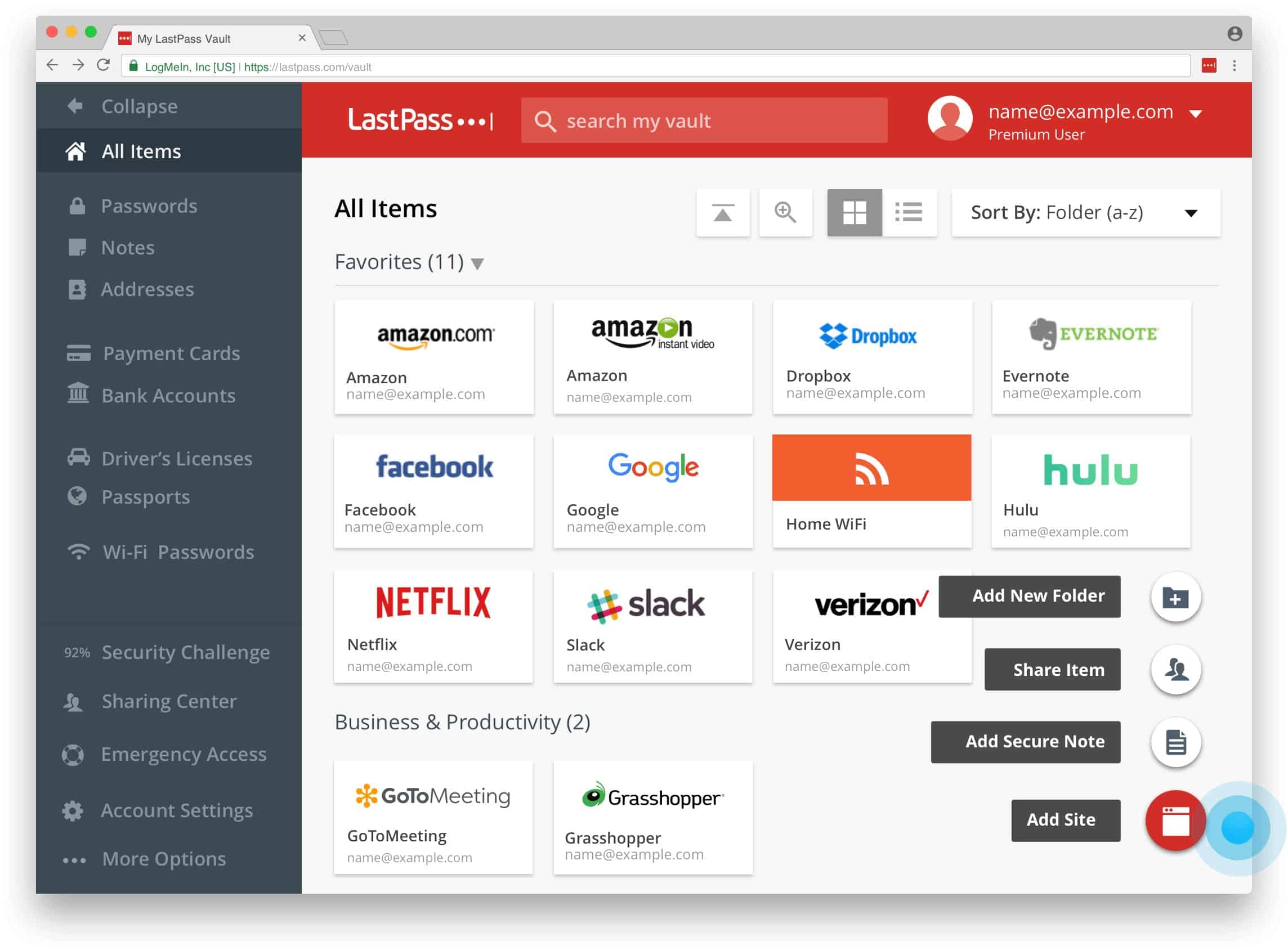Single Sign-On (SSO) tools enable authentication once to access a group of tools or services
Nowadays, businesses rely on numerous tools and services to get the job done, which can naturally slow things down. One major drawback to using multiple services is authenticating to each one every time you need access. Let’s take a look at some of the best SSO tools on the market today.
Here is our list of the six best SSO tools:
- ManageEngine Identity Manager Plus EDITORS CHOICE Offers simple but powerful SSO and identity management in a single solution.
- AWS SSO Provides SSO services for AWS environments directly through the AWS Admin Console.
- OneLogin Single Sign-On Offers multiple forms of authentication, including social media and shared logins.
- Keeper SSO Combines password management with SSO features.
- ManageEngine Password Manager Pro Focuses heavily on password management and credential access while offering SSO services.
- LastPass SSO Offers flexible SSO with password management for both personal and business use.
What to look for in an SSO tool
Not all SSO tools are built the same; knowing what features to look for ahead of time helps you avoid wasting time with too many options. Frequently, SSO services are paired with other tools such as password management and user identification.
Look for SSO tools that integrate with the way your users authenticate or need to authenticate to remain compliant. For example, if access to a particular system requires intelligent card access, ensure the product you’re using supports intelligent card authentication SSO.
Understand which applications need SSO authentication and make a note of them; when choosing a product, look for an SSO solution that was a vast amount of integrations that cover the services you need.
Look for products that allow you to customize access and permissions flexibly. For example, ask yourself if the SSO tool can support different access groups. This helps make access management easier. It’s also worth noting which products use what kind of authentication methods. For example, SSO tools can authenticate users using Kerberos, Smart Cards, Security Authentication Markup Language (SAML), and Oauth.
SSO tools help organizations balance convenient user access while still maintaining a high level of security and privacy. While SSO isn’t always the best option for small teams, it often improves small to enterprise-sized organizations’ workflow and security posture. That said, investing in an SSO solution can dramatically cut down on account lockout tickets, forgotten passwords and increasing productivity among teams.
On the front end, users need to remember multiple credentials to access different systems in your organization. This can be a hassle and lead to frequent lockouts or passwords being store improperly.
On the back end, administrators have to manage controlling access across each environment, which, when done manually, can be slow and cumbersome. When this process slows down too much, it can become a security issue. In addition, if a user is unexpectedly terminated or is causing harm to the company, it can take significant time to restrict their access across all applications.
With that said, let’s get into our top picks for the best SSO tools.
The Six Best SSO Tools
1. ManageEngine Identity Manager Plus
ManageEngine Identity Manager Plus provides secure single sign-on access across an entire organization. In addition, it is supporting dozens of different applications and use cases. As a result, the platform allows users simple one-click access to their business applications with minimal friction and steps.
Identity Manager Plus supports multiple authentication types such as SAML, OAuth, and OpenID Connect, meaning it can integrate nearly all applications on the market. API integrations extend this functionality even further to allow for SSO to be applied to your custom build environments as well.
For companies leveraging 365, GSuite, or Active Directory, users will be able to use their existing credentials for authentication without changing passwords or disturbing the way users already work.
Centralized credential management can be applied to both in-house applications and SaaS tools from the same place, keeping maintenance tasks more streamlined. In addition, administrators can modify, add or remove users in bulk, allowing the organization to scale the tools they use without slowing down the onboarding process for new hires.
Lastly, administrators can review critical metrics recorded across all SSO services to make better decisions and even uncover improper usage. Metrics such as user access, full use, and administrative activities can all be view through a live dashboard or exported in report format.
Pros:
- Multiple authentication methods supported fully
- Has a vast amount of integrations and extensive API library
- Bulk user management across multiple applications
- Key usage metrics for administrators that can easily be converted to reports
Cons:
- ManageEngine has many different products and options that can take time to explore fully
Pricing starts at $1.00 per user, per year making this an affordable and flexible SSO option for nearly any size business. However, you cant test out ManageEngine Identity Manager Plus for yourself completely free through a 30-day trial.
2. AWS SSO
AWS SSO can help you use a single method for authentication and access on your Amazon Cloud applications for companies that work primarily with Amazon services and tools. This is particularly useful for companies that want to leverage on-premise services such as Active Directory to authenticate users accessing AWS cloud services. Technicians using AWS command-line interface and accessing SDKs can also authenticate using their SSO credentials from that application,
Currently, AWS SSO supports SAML 2.0 ldP, AWS SSO, and Active Directory for identity sources. On the backend, administrators can manage users permissions centrally sorting through AWS accounts, AWS apps, or SAML-enabled applications. I do not like the backend AWS interface and found it tougher to navigate. However, after some with the product, I was able to catch on eventually. However, therein. It is room for improvement when it comes to features like role selection in the AWS SSO dashboard.
Suppose you’re already heavily invested in AWS tools and infrastructure. In that case, AWS SSO provides the tools you need to use AWS for SSO or link other forms of identity management into your cloud environment.
Pros:
- Good fit for those already extensively using AWS services
- Built directly into the AWS console
- Supports SSO for SDK and CLI access
Cons:
- Lacks in-depth reporting capabilities and usage metrics
- Not the best option if you rarely use AWS products
- Admin console could use a redesign and be easier to use
3. OneLogin Single Sign-On
OneLogin Single Sign-On acts as a single portal for users to access multiple services and applications. The platform does a great job at balancing ease of use with customizable controls and features. The platform acts as a real Identity and Access Management (IAM) system, providing access to multiple services through a single form of identification.
OneLogin secures sessions through password-based authentication, two-factor authentication, and context-aware access. While most SSO tools offer these features, having a system that provides contextual awareness to sessions adds an extra layer of security to the mix.
This contextual awareness is achieved by monitoring user behavior and measuring logins against the baseline of past logins. Machine learning can detect high-risk logins and either alert security teams or enforce a step-up authentication challenge. This authentication method can help reduce the number of times users need two-factor authentication while still keeping their accounts secure.
OneLogin offers also offers a service called OneLogin Desktop, which acts as a form of endpoint management. Once users authenticate by logging in, they can access their secure applications on that device without an additional login. This can help users save time and work more efficiently. However, while I like the convenience of this, part of me is worried that improper logout procedures or stolen devices could lead to a higher risk of compromise with this enabled.
Just like desktop authentication, OneLogin also offers social media authentication, leveraging the identity of a single social media profile. While this might not be the best fit for business use, it’s still good to know the option exists.
Lastly, OneLogin supports shared logins across multiple users, even when the application doesn’t help it. For example, FedEx doesn’t support multiple user logins. With OneLogin, you can create SSO credentials for various users to access the same account. This helps provide complete access to the application while also protecting each user’s audit trail and privacy.
Pros:
- Multiple forms of authentication
- Supports shared login SSO
- Acts as an IAM tool
- Flexible pricing
Cons:
- No custom landing/login pages
- Pricing is higher when compared to some competitors
- Would like to see a broader range of administrative API access
Pricing is flexible, and each feature is available a la carte with SSO starting at $2.00 per user.
4. Keeper SSO
Keeper SSO utilizes end-to-end encryption to provide secure access to passwords and authentication to services. In addition, the product helps bridge the gap between applications that only use SAML or OAuth by acting as an intermediary between the two.
The product integrates with many of the most popular platforms, including Office365, Azure, ADFS, Okta, Ping, JumpCloud, Centrify, OneLogin, and F5 BIG-IP APM. The site even offers integration into your SAML 2.0 compatible product if integration isn’t already present.
If you’re not already using a password manager, Keeper is a solid option as credential management is crucial to their SSO offering. Additionally, if SSO services go offline, the tool provides offline value access, so users aren’t stranded outside their applications. Keeper is highly flexible and allows businesses to implement SSO on services on-premises, in the cloud, or a hybrid environment. The whole setup process is also surprisingly fast, even when integrating identity management into your other apps.
Companies looking to enforce compliance standards such as HIPAA or GDPR can use Keeper SSO to lock down access to particular applications and services based on user groups or specific shared folders.
Pros:
- Supports multiple authentication types
- Works on-premises, in the cloud, or a hybrid configuration
- Can help organizations adhere to compliance standards
Cons:
- Sometimes automatic web fill doesn’t work.
Pricing for Keeper SSO is only supported on the Enterprise plan, which unfortunately does not have a price listed. However, you can test out Keeper SSO for yourself by requesting a trial.
5. ManageEngine Password Manager Pro
ManageEngine Password Manager Pro provides secure access and password storage for enterprise environments. Along with this secure access, businesses can implement SSO solutions from inside the product to cut down on the number of logins required by staff.
Identities and passwords can be managed across multiple cloud-based and on-premises applications and sorted into groups for easy access. For example, you can create a logical group that contains all the passwords needed for the HR department and simply add a new user to that group for access.
Passwords Manager Pro allows you to automatically reset passwords or sensitive applications and servers to help prevent shared password policies from lapsing. An exciting feature that ManageEngine Password Manager Pro offers is the ability to record and audit user access. Screen footage can be captured and stored in an audit log for all privileged logins, allow you to review them if an incident occurs.
Users can also automate requests to access specific credentials, speeding up the time it takes to access a resource and limiting the number of new tickets generated in the help desk for account access. In addition, access can be restricted to specific users, levels of entry, and even a particular timeframe.
The ManageEngine platform supports a wide range of integrations allowing users to log in and leverages their Active Directory environment for authentication through LDAP or other identity management servers. One of my favorite features includes the option to execute post password reset scripts. Additionally, you can easily send notifications to the end-user to let them know their password has been changed or fire off additional automation.
While ManageEngine Password Manager Pro goes beyond a simple SSO tool, I feel like it deserves mention as it brings a lot to the table to help sysadmins implement SSO while offering secure credential storage.
Pros:
- Works well in MSP environments as well as in mid-size organizations
- It offers a robust library of templates to get started quickly
- Manages documentation as well as credentials
Cons:
- Smaller networks may not benefit from the MSP/enterprise-specific tools the product offers
6. LastPass SSO
LastPass is a popular password management tool that also offers SSO as a combined or standalone service. The power of LastPass comes from its large number of integrations supporting over 1200 different applications and services. In addition, their robust API library paired with their support allows businesses to build custom APIs to integrate with older legacy systems. It.
Their SSO offering is pretty standard but particularly excels at being end-user friendly. Even users who have never used SSO or a password manager often have little trouble working with LastPass. The platform has taken steps to keep the tool as secure as possible. Encryption keys never leave the user’s device, preventing them from ever being stolen in transit.
Sysadmins will be happy to hear the platform has a dedicated section to automate onboarding. Simply set your one username and password and apply them to the vital roles or user groups. In addition, IT teams get access to additional IAM tools accessible from both web consoles and mobile apps if you choose the business plan.
Pros:
- User friendly
- Vast API library and support for integrations
- Supports both business and personal accounts
- It has a free version for personal use
Cons:
- Limits synching for free users
- Form filling can have issues and not support all data types
LastPass SSO is an add-on to LastPass Business, ranging from $3.00 to $8.00 per user each year. When compared to similar products, that is a bit on the higher side; however, the unlimited free trial version will give you a feel if LastPass SSO is a good fit or not.
Which SSO tool is best for you?
We’ve taken a look at some of the best SSO tools available, but how do you know which to choose? For most medium, enterprise-level companies ManageEngine Identity Manager Plus will provide you with the best SSO services combined with additional identity management features.
Identity Manager Plus allows you to implement SSO while also giving you access to the data behind each sign-on. This is especially powerful as organizations scale and needs to think about their overall security posture and the implications of an account takeover or insider attack.
The tool offers one of the widest ranges of integrations and authentication methods while also being part of the much larger ManageEngine ecosystem. This creates flexibility and makes integration easy if you decide to implement other solutions such as application monitoring.
How do you manage application access at your organization? Do you use SSO? Let us know in the comments below.
L’article 6 Best SSO Tools for 2021 est apparu en premier sur Comparitech.







0 Commentaires